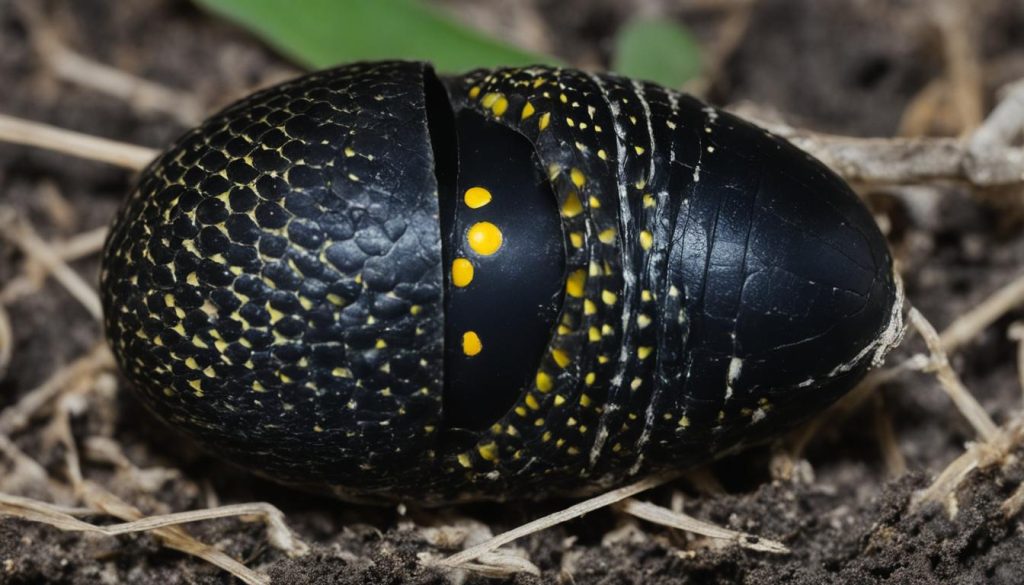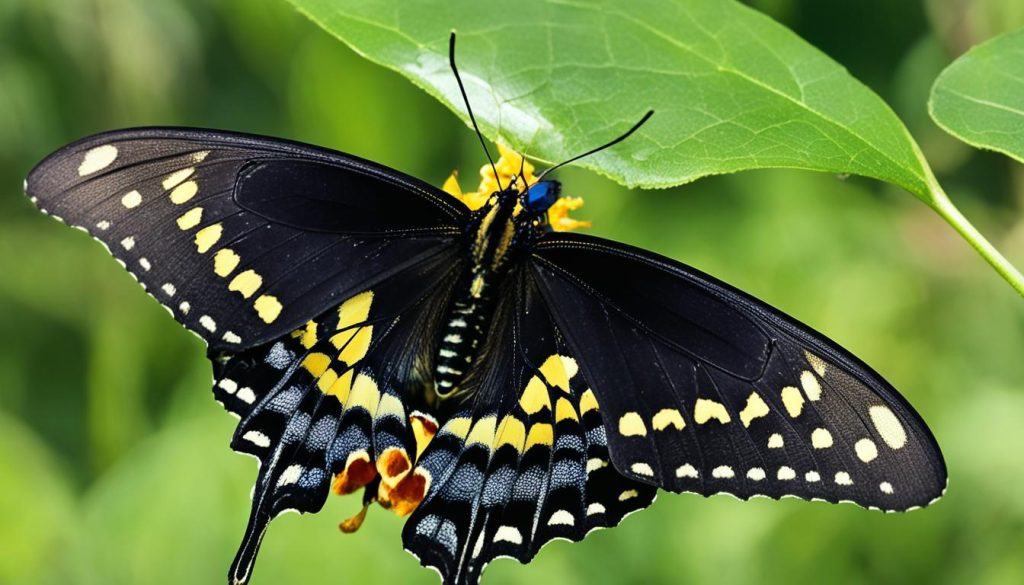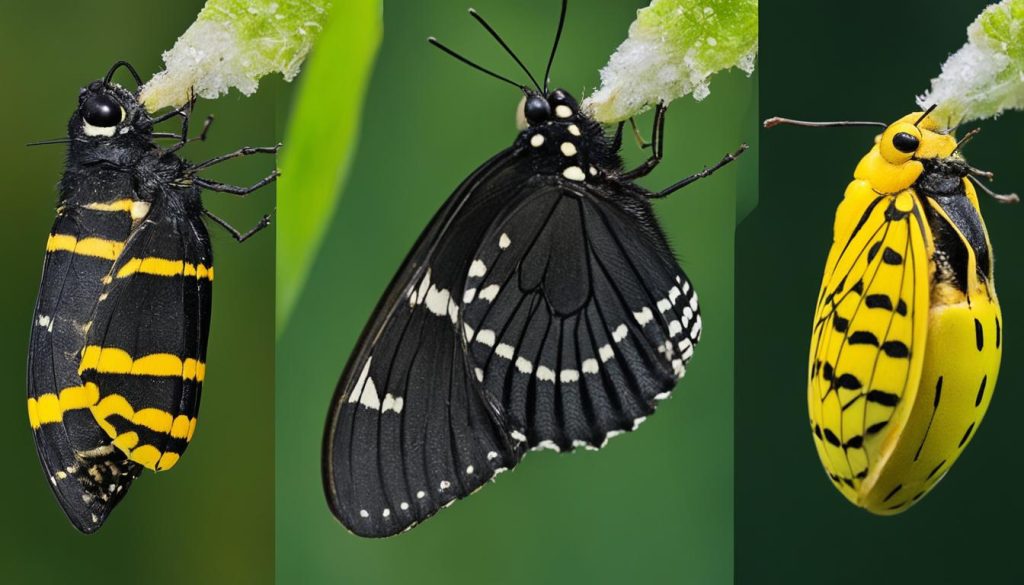Have you ever wondered about the fascinating life cycle of the black swallowtail butterfly? From egg to adult butterfly, this incredible creature goes through several stages of growth and transformation. Understanding the timeline of this process can provide a deeper appreciation for the beauty and complexity of nature.
The black swallowtail life cycle begins with the egg stage, where the female butterfly lays yellow-colored eggs on host plants like parsley, dill, and fennel. After a few days, the eggs hatch into larvae, also known as caterpillars. These caterpillars go through several growth stages, shedding their skin and consuming food from the host plants.
Once the caterpillars have reached their full size, they enter the pupal stage. They attach themselves to a plant or other surface using silk and form a chrysalis. Inside the chrysalis, a remarkable transformation takes place as the caterpillar turns into an adult butterfly. This stage can last for a couple of weeks or even overwinter in colder regions.
Finally, the adult black swallowtail butterfly emerges from the chrysalis, spreading its wings and pumping fluids into them to expand. At this stage, the butterfly feeds on flower nectar and can be found in various habitats, including meadows, parks, and suburban areas. The lifespan of a black swallowtail butterfly can range from several weeks to a couple of months.
Key Takeaways:
- The black swallowtail butterfly undergoes a fascinating life cycle from egg to adult butterfly.
- The life cycle includes stages such as egg, larva (caterpillar), pupa (chrysalis), and adult.
- Understanding the timeline of the life cycle helps us appreciate the beauty and diversity of nature.
- The adult black swallowtail butterfly emerges from the chrysalis and feeds on flower nectar.
- Preserving habitats is crucial for the survival of these enchanting creatures.
The Beginning Stages – Egg to Larva

The first stage in the black swallowtail life cycle is the egg stage. Adult female butterflies lay their yellow-colored eggs on host plants such as parsley, dill, and fennel. It takes approximately three to five days for the eggs to hatch. Once hatched, the larvae, also known as caterpillars, go through several growth stages, shedding their skin and changing in appearance as they consume food from the host plants.
Black Swallowtail Caterpillar Growth Stages:
| Stage | Description |
|---|---|
| First Instar | The caterpillar is small and black with white spots. It grows rapidly and molts. |
| Second Instar | The caterpillar becomes green with black bands and continues to grow. |
| Third Instar | The caterpillar develops more defined black bands and yellow spots. |
| Fourth Instar | The caterpillar becomes larger and starts to resemble the final larval form. |
| Fifth Instar | The caterpillar reaches its full size and prepares for the next stage. |
As the black swallowtail caterpillar grows through these stages, it molts its skin several times, shedding the old skin to accommodate its increasing size. This process of growth and molting allows the caterpillar to develop and prepares it for the next transformational stage in its life cycle.
The Transformation – Pupa Development
Once black swallowtail caterpillars have reached their full size, they embark on a remarkable transformation during the pupal stage. They attach themselves to a plant or other surface using silk and form a chrysalis, where the magic of metamorphosis takes place.
The black swallowtail pupa development is a crucial stage in the butterfly’s life cycle, where it undergoes significant internal and external changes. Inside the chrysalis, the caterpillar’s entire body is broken down and rebuilt into the intricate structure of an adult butterfly.
The pupal stage of the black swallowtail butterfly can last for two to three weeks. However, in colder regions or during the winter season, the pupa may overwinter, extending this period of development before the emergence of the adult butterfly.
This fascinating process showcases the resilience and adaptability of these beautiful insects as they undergo a complete metamorphosis. The black swallowtail pupa development captivates observers with the anticipation of the upcoming emergence of an adult butterfly.
Black Swallowtail Pupa Development
| Stage | Duration |
|---|---|
| Pupal Stage | 2-3 weeks |
| Overwintering Pupa | Extended period |
During the pupal stage, the black swallowtail butterfly undergoes a remarkable transformation from a caterpillar to an adult butterfly. This process of metamorphosis is a testament to the incredible abilities of these creatures and highlights the beauty and diversity of nature.
Now that we’ve explored the pupal stage of the black swallowtail butterfly, we can move on to the final stage of its life cycle – the emergence of the adult butterfly.
From Chrysalis to Flight – Adult Emergence

Once the metamorphosis is complete, the adult black swallowtail butterfly emerges from the chrysalis. At this stage, the wings are expanded as the butterfly pumps fluids into them. Adult black swallowtails feed on flower nectar and can be found in various habitats, including meadows, parks, and suburban areas. They mate, lay their eggs, and continue the life cycle for future generations. The lifespan of a black swallowtail butterfly is typically several weeks to a couple of months.
An exciting moment in the black swallowtail life cycle is the emergence of the adult butterfly from the chrysalis. As the transformation concludes, the adult butterfly unfolds its wings and prepares for flight. During this critical stage, the butterfly pumps fluid into its wings, expanding them to their full size and strength.
The adult black swallowtail butterfly, with its distinctive black wings bordered by yellow and blue spots, is a beautiful sight to behold. Its graceful flight and delicate appearance add vibrance to meadows, parks, and suburban gardens. As Pollard, a reputable entomologist, says, “Observing the emergence of a black swallowtail butterfly is a true marvel of nature—the culmination of the fascinating stages of development.”
Once the black swallowtail reaches adulthood, it begins its quest for nourishment. Like other butterfly species, adult black swallowtails feed on flower nectar, acting as essential pollinators in their habitats. They play a vital role in maintaining the balance and biodiversity of ecosystems.
The lifespan of a black swallowtail butterfly varies, typically ranging from several weeks to a couple of months, depending on various factors such as environmental conditions and predation. During their lifespan, black swallowtails continue the life cycle by mating and laying eggs on suitable host plants. The continuation of this extraordinary cycle ensures the survival and propagation of the black swallowtail species.
Appreciating the Black Swallowtail Life Cycle
The life cycle of the black swallowtail butterfly is a captivating marvel of nature. From the moment the tiny eggs hatch into voracious caterpillars, to the breathtaking emergence of the adult butterflies, each stage holds its own significance and contributes to the overall beauty and diversity of the natural world.
Understanding and appreciating the black swallowtail life cycle opens our eyes to the intricacies of nature’s transformation. Witnessing the miraculous process from egg to caterpillar, then to pupa and finally to butterfly, we gain a deeper connection with the natural world around us.
Preserving the habitats that support this enchanting creature is crucial. By protecting the host plants and creating suitable environments, we play a vital role in ensuring the continuation of the black swallowtail butterfly’s lifecycle. We have the power to safeguard these delicate and graceful creatures, allowing future generations to admire and learn from their captivating journey.
FAQ
What is the life cycle of a black swallowtail butterfly?
The black swallowtail butterfly goes through several stages in its life cycle, starting with the egg stage, followed by the larva or caterpillar stage, the pupa or chrysalis stage, and finally, the adult butterfly stage.
How long does it take for black swallowtail eggs to hatch?
Black swallowtail eggs take approximately three to five days to hatch.
What do black swallowtail caterpillars eat?
Black swallowtail caterpillars feed on host plants such as parsley, dill, and fennel.
How long does the pupa stage of a black swallowtail butterfly last?
The pupa stage of a black swallowtail butterfly can last for two to three weeks. In colder regions, it may even overwinter before the adult butterfly emerges.
How do black swallowtail butterflies emerge from their chrysalis?
Adult black swallowtail butterflies emerge from their chrysalis by expanding their wings as they pump fluids into them.
What do adult black swallowtail butterflies eat?
Adult black swallowtail butterflies feed on flower nectar from various plants.
How long do black swallowtail butterflies live?
The lifespan of a black swallowtail butterfly is typically several weeks to a couple of months.
Why is it important to understand and appreciate the black swallowtail life cycle?
Understanding and appreciating the black swallowtail life cycle helps us connect with the natural world and emphasizes the importance of preserving habitats for these enchanting creatures.






